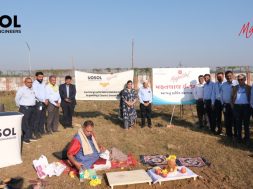
India has already announced its target of 175 GW of installed renewable energy capacity, to be achieved by the year 2022. Today, the total installed electricity generation capacity of India is about 366 Gigawatts (GW) and 23% of this — about 84 GW — is from Renewable Energy Sources (RES), according to the (Ministry of Power, as on January 2020). India showed significant growth in renewable based installed capacities in the last decade. The Compound Annual Growth Rate (CAGR) for installed generating capacity in electricity from 2008-2018 using RES stands at 18%, whereas the growth rate for thermal power for the same period is 9.05% (Ministry of Statistics and Programme Implementation, 2019). The Renewable Energy (RE) targets and the trends overall show a promising future for RE in India. This is likely to lead to enhanced job opportunities.
The Council on Energy, Environment and Water (CEEW) and the Natural Resources Defense Council (NRDC) suggest that that many as 1 million Full Time Equivalent (FTE) jobs could be created if India achieves its target of 100 GW of installed solar energy by 2022 ,and another 183,500 FTE jobs will be generated if India reaches the target of 60 GW of wind energy capacity (CEEW and NRDC, 2016). The numbers will escalate exponentially if the decentralized renewable based options (such as off grid RE based power plants and household RE technologies for electricity and heating) are also considered. How do we envisage the role of women in this expanding space of Renewable Energy (RE)? Limited literature is available on the direct job creations associated with RE and few literature speaks about women’s possible role.
Typically, the jobs in RE can be segregated into four phases (see the figure below). Worldwide, female representation in the RE workforce is 32% (International Renewable Energy Agency, 2019). Further, 45% of the female representation is in administrative jobs, while the percentage for STEM[1] and non STEM technical jobs are 28 and 35, respectively. No such published consolidated data is available for India. International Energy Agency (IEA) provided figures for solar rooftop companies in India. The office-based positions (such as design & pre-construction phase) and the corporate segment have a relatively high share of female employees at 18% and 34%, respectively (IEA and CEEW, 2019). In the area of construction and commissioning, women constitute 3%, an, in operations and maintenance, they make up a mere 1%. This distribution pattern is also a representation of preference for office based positions over site based positions among the women with requisite expertise and skills[2].
Figure 1: Jobs in RE

Another option to look at is decentralized RE solutions. Women’s participation in manufacturing, repair and maintenance of household level renewable energy systems (such as solar lamps, improved cookstoves) are well documented. At a commercial level, solar lamps in the low cost range are available in rural markets/haats[3]. In the majority of the renewable based livelihood projects, women are considered to be the primary users of RE technologies to enhance their productivity rather than being the team associated with the promotion and installation of RE. With improving household electrification rates in India, the role of off grid power plants will be re-defined. Thus, in the changing household energy scenario, the role of women in the RE jobs will also be relooked. The role of women in RE jobs will now be viewed through the lens of shifting patterns in RE: the increasing space of grid connected RE systems and reducing space of off-grid & household level RE systems.
Two levels of job opportunities are available in RE. One is at the expertise level – it concerns project development and STEM related jobs. Women with expertise in terms of education and experiences are likely to find their way in these areas, though their representation is towards the lower side in gender terms. Strengthening measures, such as the creation of cohorts for women in RE STEM level jobs, will help in sharing the challenges and career pathways among women. Such cohorts may also influence women students in STEM streams to join RE jobs. There is also a need to encourage women to take up higher level courses and studies in RE at the university level through special incentives.
Another level of jobs in RE is skill-based such as in manufacturing, repair, maintenance and sales. However, the participation of women is skill development initiatives in RE are mostly restricted towards the maintenance of home based devices like solar lanterns or improved cookstoves. In this changing scenario for RE, it is now important to identify and impart skills to women to attain gainful employment in the grid connected RE as well. RE companies may be encouraged to provide intern and apprentice opportunities to qualified women to provide them with a boost towards their ultimate employment. These skill based jobs in RE have the potential to engage women with limited educational qualifications.
India being a country leading the International Solar Alliance (ISA) and with a huge targets for RE has much more promising options to enhance women’s participation in increasing RE capacities. Skill development has been a major initiative of the government of India, especially of the previous and the re-elected government. At national level, institutes like National Institute of Solar Energy (NISE) and Skill Council for Green Jobs are already being raised. Now, it is the time for enhancing gender inclusion in these skill development initiatives at various levels of RE implementation. This includes projects at the MW scale. National skilling goals may introduce specific targets for women to be skilled across the complete spectrum of RE. We need to envisage women in various roles performing STEM and non-STEM technical jobs for grid connected as well as home based RE systems.
References:
CEEW and NRDC. (2016). Filling the Skill Gap in India’s Clean Energy Market: Solar Energy Focus. Policy Brief, Council on Energy, Environment and Water (CEEW) and the Natural Resources Defense Council (NRDC). Retrieved from https://www.nrdc.org/sites/default/files/renewable-energy-solar-skill-gap.pdf
IEA and CEEW. (2019). Women Working in the Rooftop Solar Sector: A Look at India’s Transition to Clean Energy.
International Renewable Energy Agency. (2019). Renewable Energy: A Gender Perspective.
Ministry of Power. (as on January 2020).
Ministry of Statistics and Programme Implementation. (2019). Energy Statistics 2019. Government of India, New Delhi. Retrieved January 2020
Comments
General comments on key points raised
- The title suggests that the piece may discuss why the renewable energy (RE) sector is different for Indian women compared to other technology sectors but this does not come out in the piece; consequently it sounds less like an expert (on gender issues for example) opinion and more like a journalists summary of what is happening in the sector which apparently is not different from any other technology sector
- It is not clear if the piece only wants to point out that RE is a growth sector and women may find more opportunities for employment. This is true for any technology growth sector. What makes RE different? This is a question for an expert.
- The data such as women constitute 32% of the workforce in the RE sector may be contextualised with data on what is the share in other sectors to make the point that RE is different.
- Overall the author may want to sharpen arguments to either claim that the RE sector is likely to be different for women or that India is likely to make the RE sector different for women or that RE is not likely to be different from any other technology sector and give some expert opinion (theoretically grounded views on gender discrimination at the workplace for example) and how certain features of the RE sector (for example modular nature of PV or technology intensive nature of RE) will alter (improve or erode) circumstances for women
- There are some sweeping statements that are not substantiated. g. Second para line 4: “The numbers will escalate manifolds..” The author may want to either change the tone or qualify the statement
- The piece will benefit from some editorial and copy editing inputs: e.g opening line: “India has already announced …. “
[1] Science, Technology, Engineering and Mathematics
[2] Author’s inferences based on various published and unpublished reports and conference proceedings
[3] Based on author’s observation and interactions while taking travel in the rural and remote locations in India













